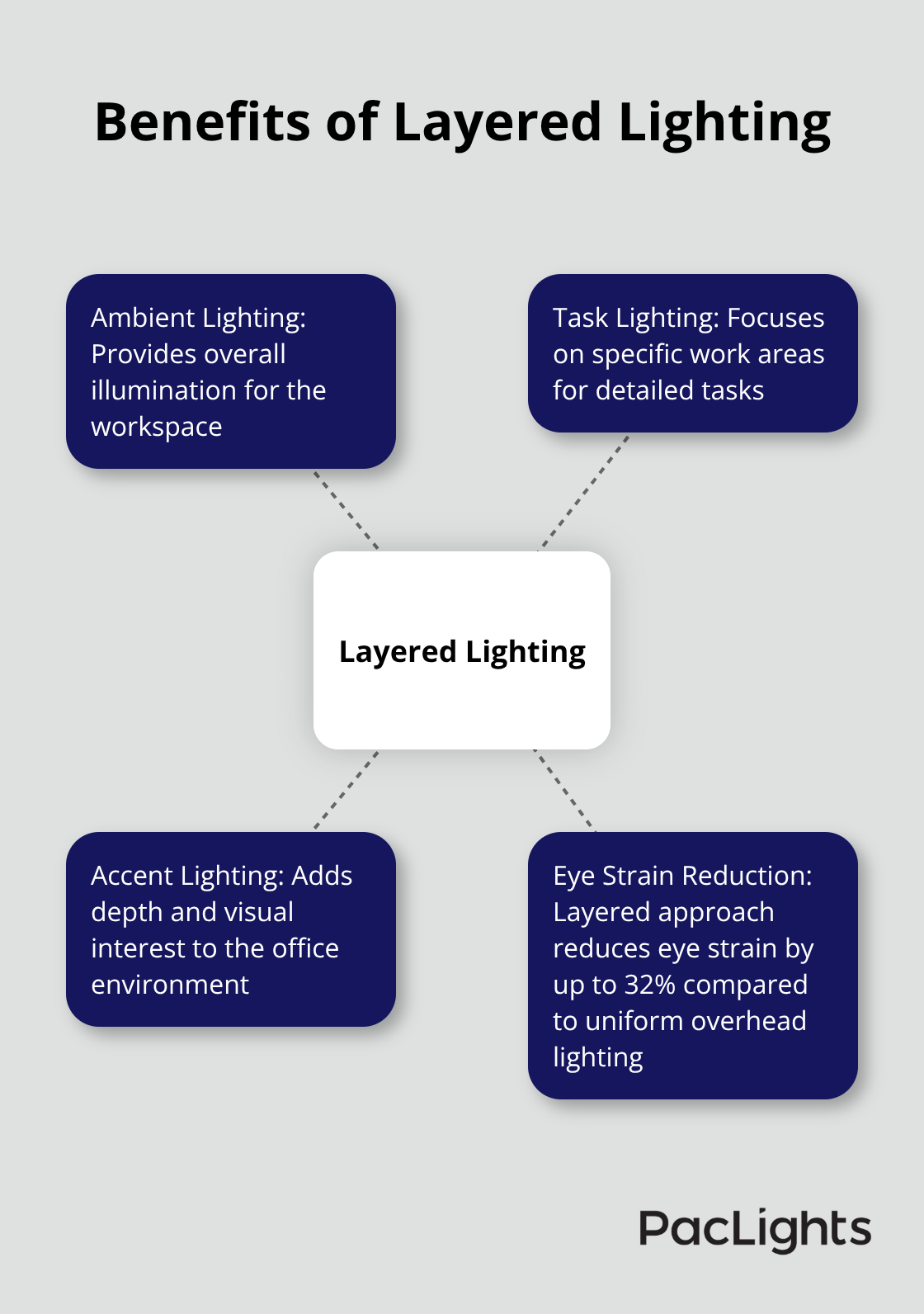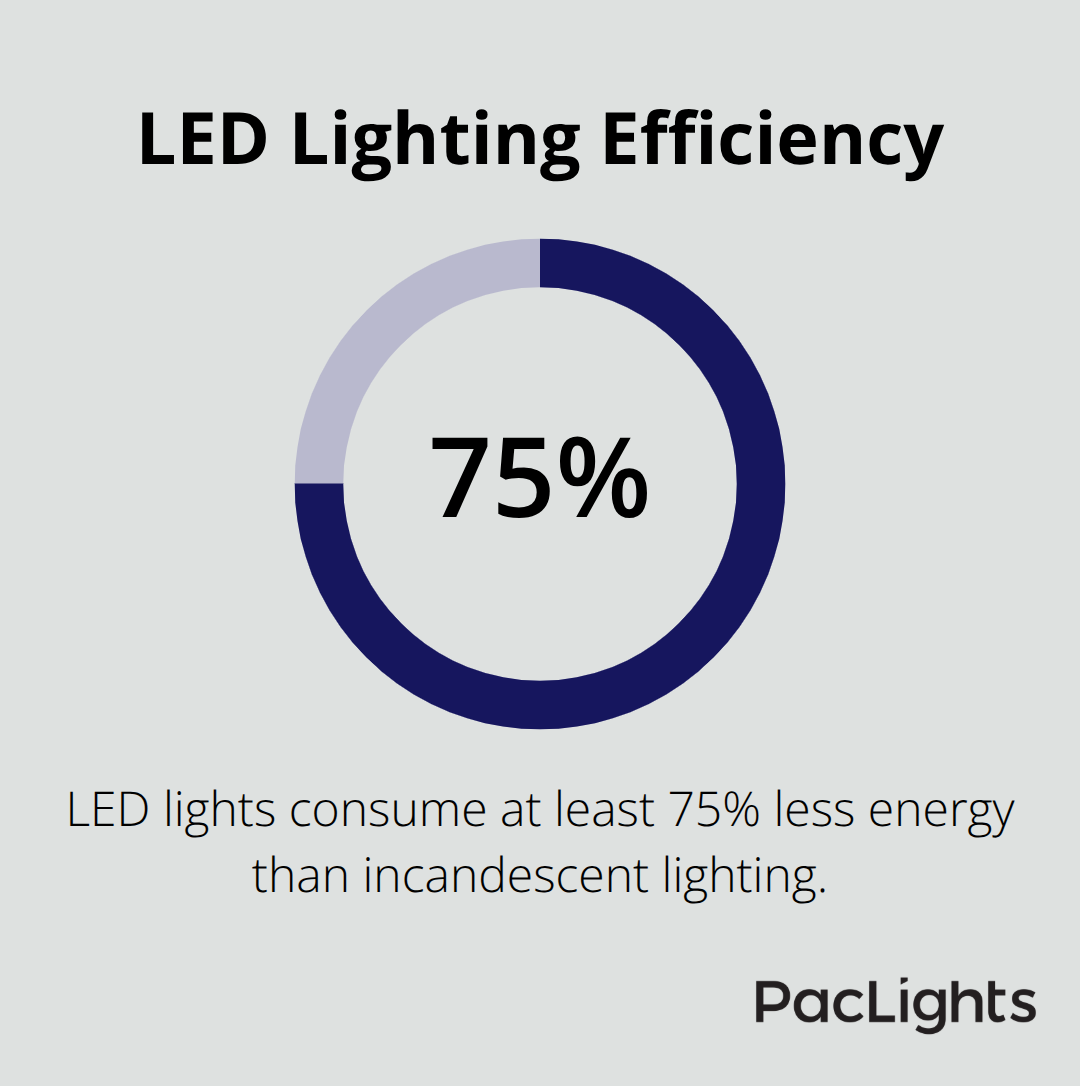Office illumination plays a pivotal role in shaping workplace productivity and employee well-being.
At PacLights, we understand the profound impact that lighting has on performance, creativity, and overall job satisfaction.
This guide will explore the key elements of effective office lighting design and introduce innovative solutions to transform your workspace into a beacon of productivity.
How Lighting Shapes Workplace Performance
The Performance-Light Connection
Office lighting transcends mere illumination; it serves as a powerful tool that molds employee performance and well-being. Studies reveal that proper lighting can boost productivity by up to 20%. The Illuminating Engineering Society (IES) recommends 300-500 lux for general office work, with higher levels of 750-1,000 lux for detailed tasks. These guidelines stem from extensive research into human visual comfort and performance.
A study by the American Society of Interior Design uncovered that 68% of employees express dissatisfaction with their office lighting. This discontent directly impacts work quality and efficiency. Companies that address these concerns with tailored lighting solutions often witness immediate improvements in output and employee satisfaction.

Lighting and Mental Health at Work
The connection between lighting and mental health stands undeniable. Poor lighting often results in eye strain, headaches, and fatigue – all of which contribute to decreased mental well-being and productivity. Well-designed lighting, on the other hand, can elevate mood and energy levels.
Natural light exposure in the office improves sleep quality by up to 46 minutes per night (according to a study published in the Journal of Clinical Sleep Medicine). This translates to more alert, focused employees during work hours. When natural light proves scarce, high-quality LED lighting that mimics daylight can provide similar benefits.
Common Lighting Pitfalls in Offices
Many offices grapple with lighting issues that hinder productivity. Glare on computer screens, uneven light distribution, and flickering fluorescent tubes rank among the common culprits. These problems not only cause physical discomfort but also lead to decreased concentration and increased errors.
Another often-overlooked issue involves the lack of adjustable lighting. Different tasks require varying light levels, and what works for one employee might not suit another. Implementing adjustable lighting systems allows for personalization and optimal working conditions for each individual.
The Role of Color Temperature
Color temperature plays a significant role in office lighting design. Cooler temperatures (5000K-6500K) promote alertness and concentration, making them ideal for task-oriented areas. Warmer temperatures (2700K-3000K) create a more relaxed atmosphere, suitable for break rooms or creative spaces. Understanding and implementing the right color temperature for each area can significantly enhance workplace productivity.
Innovative Lighting Solutions
Modern offices now embrace innovative lighting solutions to address these challenges. Smart lighting systems offer personalized control, allowing employees to adjust brightness and color temperature to their preferences. Human-centric lighting approaches mimic the natural progression of daylight, supporting the body’s circadian rhythm and improving overall well-being.
As we move forward, let’s explore the key elements of effective office lighting design that can transform your workspace into a beacon of productivity.
How to Design Effective Office Lighting
The Power of Color Temperature
Color temperature impacts mood and productivity in the workplace. Cooler light temperatures (5000K-6500K) promote alertness and concentration, making them ideal for task-oriented areas. Warmer temperatures (2700K-3000K) create a more relaxed atmosphere, suitable for break rooms or creative spaces.
A University of Greenwich study found that workers under blue-enriched light bulbs reported feeling happier, more alert, and experienced less eye strain. Companies should implement adjustable color temperature lighting systems to cater to different tasks and times of day. This flexibility allows employees to optimize their workspace for peak performance.
Layered Lighting for Versatility
Layered lighting combines ambient, task, and accent lighting to create a well-rounded and adaptable environment. Ambient lighting provides overall illumination, task lighting focuses on specific work areas, and accent lighting adds depth and visual interest.
The Illuminating Engineering Society (IES) reports that a layered approach can reduce eye strain by up to 32% compared to uniform overhead lighting. Companies should implement a mix of ceiling fixtures, desk lamps, and wall-mounted lights to achieve this effect. This strategy allows employees to adjust their lighting based on individual needs and tasks.

Balancing Natural and Artificial Light
Natural light enhances productivity and well-being. A study published in the Journal of Clinical Sleep Medicine found that employees with more natural light exposure slept an average of 46 minutes more per night, leading to improved cognitive function during work hours.
However, relying solely on natural light can lead to inconsistencies and glare. Companies should supplement daylight with artificial lighting that automatically adjusts based on available natural light. This approach, known as daylight harvesting, can reduce energy consumption by up to 40% while maintaining optimal light levels throughout the day.
Minimizing Glare and Eye Strain
Glare from both natural and artificial light sources can cause significant discomfort and reduce productivity. The American Optometric Association reports that 58% of office workers experience eye strain due to poor lighting conditions.
To combat this issue, companies should position computer screens perpendicular to windows and use anti-glare filters. For artificial lighting, indirect or diffused light sources that distribute light evenly across the workspace are optimal. Many lighting manufacturers (including PacLights) offer LED fixtures with advanced glare control features, ensuring comfortable illumination for all office tasks.
The implementation of these key elements of effective office lighting design creates a workspace that not only looks great but also actively supports employee productivity and well-being. Regular assessments and adjustments based on employee feedback are essential for maintaining an optimal work environment. As we move forward, let’s explore innovative lighting solutions that are revolutionizing modern offices.
Revolutionizing Office Lighting with Innovative Solutions
LED Technology: The Cornerstone of Modern Illumination
LED technology forms the foundation of modern office lighting. The U.S. Department of Energy reports that LEDs consume at least 75% less energy and last 25 times longer than incandescent lighting. This translates to substantial cost savings and reduced maintenance for businesses. LED fixtures provide superior light quality and offer unparalleled flexibility in design and control.

Smart Lighting Systems: Personalized Illumination
Smart lighting systems transform how we interact with our work environments. These systems allow precise control over brightness, color temperature, and individual fixture operation. The American Society of Interior Designers found that 68% of employees express dissatisfaction with their office lighting. Smart lighting addresses this issue by enabling personalization.
Companies can program task-based lighting scenes, activated with a single touch. Morning routines might involve cooler, energizing light, while afternoon settings could shift to warmer tones to maintain focus. Some advanced systems integrate with calendar apps, automatically adjusting lighting for different activities (e.g., presentations or brainstorming sessions).
Human-Centric Lighting: Synchronizing with Natural Rhythms
Human-centric lighting takes customization further by replicating the natural progression of daylight. This approach supports our circadian rhythms, potentially improving sleep quality and daytime alertness. A study in the Journal of Clinical Sleep Medicine revealed that office workers with more natural light exposure slept an average of 46 minutes more per night.
Implementation of human-centric lighting involves the use of tunable white LEDs that adjust color temperature throughout the day. Morning light might start at a cool 6500K, gradually warming to 3000K by evening. This subtle shift can profoundly affect employee well-being and productivity.
Energy Efficiency: Sustainable and Cost-Effective Solutions
Energy-efficient lighting options reduce operational costs and contribute to sustainability goals. The U.S. Environmental Protection Agency estimates that if all office buildings in the U.S. switched to LED lighting, it would save enough energy to power 1.3 million homes for an entire year.
Many lighting manufacturers (including PacLights) offer energy-efficient LED solutions designed specifically for office environments. These include flat panel lights for even illumination, linear strip lights for versatile applications, and recessed down lights for focused task lighting. Many of these fixtures come with optional daylight or motion control features, further optimizing energy use.
Adaptive Lighting Controls: Maximizing Efficiency
Adaptive lighting controls enhance the capabilities of modern office lighting systems. These controls use sensors and algorithms to adjust light levels based on occupancy, time of day, and available natural light. The result is a dynamic lighting environment that maximizes energy efficiency while maintaining optimal illumination levels.
Some systems even learn from user preferences and behavior patterns, automatically adjusting settings to create the most comfortable and productive environment for each individual. This level of customization (when combined with high-quality LED fixtures) can lead to significant improvements in both energy savings and employee satisfaction.
Final Thoughts
Proper office illumination stands as a cornerstone of workplace productivity and employee well-being. Well-designed lighting solutions can boost productivity by up to 20% and significantly improve employee comfort and focus. The evidence supports the profound impact of lighting on performance, mental health, and overall job satisfaction.
Modern innovations such as LED technology, smart lighting systems, and human-centric lighting approaches have revolutionized office illumination. These advancements offer unprecedented control, energy efficiency, and alignment with our natural circadian rhythms. Adaptive lighting controls further enhance these benefits, creating dynamic environments that respond to occupancy, time of day, and available natural light.
Quality lighting products are essential in creating productive workspaces. We at PacLights offer a comprehensive range of energy-efficient LED solutions designed specifically for office environments. Our products include flat panel lights, linear strip lights, and recessed down lights (all tailored to diverse industrial needs).


Disclaimer: PacLights is not responsible for any actions taken based on the suggestions and information provided in this article, and readers should consult local building and electrical codes for proper guidance.